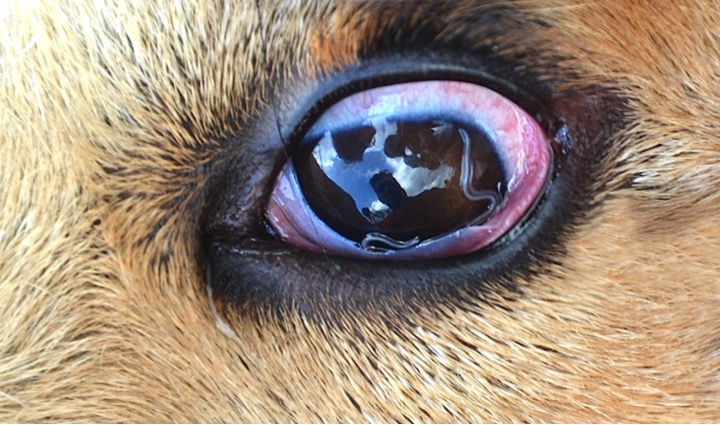Oriental Eyeworm
(Thelazia callipaeda)
Thelazia callipaeda is a spirurid of dogs, which can also be found in cats and wildlife such as foxes and hares. This parasite is transmitted by secretophagous fliesflies, which is a fruit fly that feeds on lachrymal secretions of mammals. It is zoonotic.
| Parasite: Thelazia callipaeda |
| Common name: Oriental eyeworm |
| Hosts: Dogs, cats, several wildlife species, humans |
| Pre-patent period: 3 weeks |
| Location of adults: Conjunctival sac |
| Distribution: Some parts of Asia and Europe |
| Transmission route: Secretophagous flies (Phortica variegata, Phortica okadai) |
| Zoonotic: Yes |
Distribution
Thelazia callipaeda has been reported in several parts of Europe and Asia, including China, India, Bangladesh, Myanmar, Indonesia, Japan, Korea, Taiwan, and Thailand.
Clinical signs
In most cases, T. callipaeda infection in dogs is asymptomatic, but clinical signs may include mild conjunctivitis, blepharitis, epiphora, periocular pruritus and, in severe cases, corneal oedema and keratitis (Fig 1). Blindness may eventually occur in severe cases that are left untreated.

Figure 1 Thelazia callipaeda in the eye of a dog. (Image credit: ProfDr. D. Otranto and Dr. F. Dantas-Torres, DOI: 10.1186/s13071-015-0881-7)
Diagnosis
Diagnosis is achieved by visual inspection and retrieval of adult worms in the eye of infected hosts. First-stage larvae of the parasite may also be found in ocular secretions.
Treatment
Mechanical removal of the worms by flushing saline solution in the affected eye is usually successful. Other treatments involve off-label use of anthelmintics. A single application of topical imidacloprid plus moxidectin (2.5 mg/kg) killed worms within 7 days of application. Two oral doses of milbemycin oxime (0.5 mg/kg) administered one week apart reached 100% efficacy 28 days following treatment. Alternatively, a single dose of 200 µg/kg oral ivermectin achieved 100% efficacy in 25 days.
Control
Control of T. callipaeda infections in dogs may be achieved by avoiding wooded environments inhabited by Phortica variegata and by treating infected animals.
Public health considerations
Several cases of human thelaziosis have been recorded in Asia and Europe, especially in people living near wooded environments, where the natural life cycle of this parasite takes place. Clinical signs resemble those of dogs listed above.
